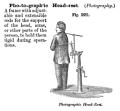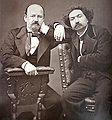| Feb 23, 2010 | 19th Century Photographic Studios: Properties, accessories and novelties | | | |
This online exhibition, which will be improved over time, lists the commonest properties to be seen in nineteenth century studio portraits. Researching material for this exhibition has been a real journey of discovery and could go on for ever.
| Interior scenes - Rarely visible |
- Head rests and clamps
- Posing rests
- Curtain stands
|
| Interior scenes - Visible |
- Chairs (vast variety of types - some specifically for babies and small children)
- Tables
- Desks
- Pedestals and columns (innumerable styles, heights and widths)
- Mantels and fireplaces
- Posing furniture (chairs, lounges)
- Day beds (a more common item in the Mediterranean and Middle East and found in photographs by the Zangaki Brothers and Pascal Sebah.)
- Beds (They only appear in post-mortem, erotic or art studio photographs. Most post-mortem photographs were carried out in the home but there were cases when the body of a child or deceased loved one was taken to a studio to preserve a memory. In the cases where children are shown in bedrooms such as some of the Lewis Carroll albumen prints it is now regarded as questionable.)
- Drapery (heavy fabrics, drapes, curtains, throws)
- Carpets, rugs, furs and other floor coverings
- Large ceramic pots and urns
- Plant and fern stands, planters and artificial plants
- Windows
- Screens
|
| Exterior scenes - Visible |
- Rustic wooden fences
- Rustic gates and stiles
- Porches
- Bridges
- Balustrades
- Benches (rustic wood and stone)
- Statues
- Pedestals
- Stone walls
- Rockwork
- Park gates
- Artificial grass, or furs used to indicate grass
- Branches, twigs, tree trunks and limbs (real or papier mache)
- Rocks
- Simulated snow (using furs or rock salt)
- Swings
- Entire rustic buildings and temples
- Transportation (mockups of sledges, hot air balloons, trains, row boats and later cars and planes)
|
When examining a photograph it can be important to see if the items in the studio match the ethnicity of the sitter. For example if the sitter is Chinese is the style of the table and chair also in the Chinese style or European.
If you have sales catalogues for photographic studio properties I'd very much like to hear from you.

PhVTitle | Lightbox | Checklist
Exhibition: 19th Century Photographic Studios: Properties, accessories and novelties
| 
| | Feb 20, 2010 | Dark tents | | | |
A selection of nineteenth century dark tents for all lovers of wet plate collodion.
| 
| | Feb 17, 2010 | Shaped by War: Photographs by Don McCullin | | | |
Imperial War Museum North in Manchester presents the largest ever UK exhibition about the life and work of Don McCullin, one of the world’s most acclaimed photographers, to mark his 75th year. Many items are on public display for the very first time. For more than 50 years, McCullin's images have shaped our awareness of modern conflict and its consequences. His courage and integrity, as well as the exceptional quality of his work, are a continuing inspiration and influence worldwide. A unique collaboration between McCullin and the Imperial War Museum, this major new exhibition contains over 200 photographs, contact sheets, objects, magazines and personal memorabilia, and shows how war has shaped the life of this exceptional British photographer and those across the globe over the last half-century.
Don McCullin is one of Britain's greatest photographers. For 50 years his photographs have shaped our awareness of modern conflict and its consequences.
Today, despite leaving photojournalism to explore other photographic genres, his work continues to be influenced by his experiences: his life has been shaped by war.
Imperial War Museum North, 6 February to 13 June 2010
Victoria Art Gallery, Bath, 11 September - 21 November 2010
Imperial War Museum London, 7 October 2011 - 30 January 2012
"Photography for me is not looking, it's feeling. If you can't feel what you're looking at, then you're never
going to get other to feel anything when they look at your pictures."
Don McCullin, “Sleeping with Ghosts” (1996)
With special thanks to Don McCullin for allowing his work to be shown on Luminous-Lint.
With thanks to the staff of the Imperial War Museum especially Alex Knight (Press and PR Manager, Imperial War Museum North), Gemma Gibb (Head of Marketing & PR, Imperial War Museum North) and Hilary Roberts (Head of Collections Management, Imperial War Museum Photograph Archive).

PhVTitle | Lightbox | Checklist
Exhibition: Shaped by War: Photographs by Don McCullin
| 
| | Feb 17, 2010 | Nineteenth century woodcuts, engravings and lithographs of photographers, their studios, darkrooms, equipment and other oddities | | | |
As a part of Luminous-Lint I continually collect images on diverse aspects of photography that I feel will be useful as this project evolves over the years. Here are a few nineteenth century additions that are rather fun - enjoy.
If you have engravings in your collection that shed light on the ever-intriguing history of photography and can share a scan I'd appreciate it. If you have the original publication source so much the better as it saves me hunting.
| 
| | Feb 12, 2010 | Photographic restoration | | | |
Digital restoration of a damaged photograph can bring fresh life to an image that could otherwise be forgotten. Within the museum and archival community there will mixed opinions on what is acceptable in restoring a poor quality original and this exhibition is to highlight some of the issues. With archival restoration of the original image it should be undectable and so the restored image never shows the hand of the skilled restorer.
With digital restoration the purpose can be different as the original image is never touched. The cloning of areas to remove original water spots from film negatives may be permissable to create a digital master for publication just as the removal of surface abrasions from the scan of a Daguerreotype can bring forth the clarity of the plate an improve scholarship. How far one can go depends on the circumstances and the addition of colour or the creation of a frame will be considered to overstep accuracy by some. Experts on fabrics and the history of fashion may question colour choices where there is no trace of tints, paints or a colour original. Specialists in early frames will question frames that do not match the somber tones and styles of the period.
This online exhibition shows us the possibilities and raises the questions and thanks to John Steele for sharing his work with us.

PhVTitle | Lightbox | Checklist
Exhibition: Photographic restoration
| 
| | Feb 11, 2010 | 2010 European Publishers Award for Photography | | | | The European Publishers Award for Photography, now in its 17th year, is a major initiative to encourage the publication of contemporary photography.
We are delighted to announce that the 2010 Award will again be sponsored by Heidelberger Druckmaschinen AG. The company is known world-wide for its Heidelberg printing presses which are recognised as being synonymous with the highest quality of offset printing.
The 2010 Jury will be held in Athens. Apeiron Photos will be the Project Leader.
Open to photographers worldwide, the competition is a unique collaboration between six European Publishers – Actes Sud (France), Apeiron (Greece), Dewi Lewis Publishing (United Kingdom), Edition Braus (Germany), Lunwerg Editores (Spain) and Peliti Associati (Italy).
The competition requires the submission of a substantial, completed and unpublished photographic book project. The winning project is then published in book form simultaneously by each of the publishers in their own country and in their own language, resulting in perhaps the most extensive cultural collaboration currently existing in Europe.
The winning book will be published in autumn 2010
Previous winners of the award are:
Klavdij Sluban, Jacob Aue Sobol, Paolo Pellegrin, Ambroise Tézenas, Lorenzo Castore, Harri Kallio, Haris Kakarouhas, Simon Norfolk, David Farrell, Dean Chapman, Alfons Alt, Jeff Mermelstein, Toni Catany, Bruce Gilden, Shanta Rao and Dario Mitidieri.
The entry form and details can be downloaded from www.dewilewispublishing.com.
|
| | Feb 10, 2010 | Call for papers: ICOM-CC Photographic Materials Working Group | | | | We are pleased to announce that the Call for Papers for the ICOM-CC's Photographic Materials Group Interim Meeting has been released, and we invite you to submit your abstract to us no later than April 31, 2010.
The conference will be held in at the Benaki Museum in Athens, Greece, 19-22 October 2010, and it will include two days of talks and two days of tours and workshops.
The theme of the meeting is Modern Materials, and papers are invited, but not limited to, the following areas: preservation issues of large format photography, ethics in the conservation of contemporary photography, and compensation for loss. Papers on topics relevant to ICOM-CC PMG that are not related to Modern Materials are also welcome.
We look forward to your participation in this conference and encourage you to submit abstracts to the program committee.
Please email questions and your submission (with authors, title and abstract) to c.waldthausen@planet.nl
Sincerely,
Clara von Waldthausen
|
| | Feb 10, 2010 | Call for Papers: Documenting History, Documenting Progress - Nineteenth Century Photographs of Architecture | | | | Call for Papers: Documenting History, Documenting Progress - Nineteenth Century Photographs of Architecture
International Symposium
October 3-4, 2010
Held during the exhibition of Snite Collection photographs of nineteenth century architecture at the Snite Museum of Art, University of Notre Dame (September 5 – October 31, 2010)
This symposium is a collaboration between the Snite Museum at the University of Notre Dame, the University of Notre Dame School of Architecture, and Indiana University South Bend. It will bring together scholars who study nineteenth century photography of architecture.
Heavily represented in collections of nineteenth century photographs, architectural photography provides inroads into major themes of the period: industry and technology, exploration and exoticism, documentation and preservation, history and nationalism, etc. However, most histories of photography use the progressive development of the medium as the organizing structure for the presentation of the material. Architecture lent itself to the long exposure times required by the early photographic processes and was used extensively as subject by the first generation of photographers. A genuine understanding of the first decades of architectural photography needs to account for the relevant technical parameters of production but also demands that each photographic image of architecture be studied as a primary visual document and an aesthetic object. It is the investigation of this multi-faceted enquiry that is invited in this symposium on nineteenth-century architectural photography.
Abstracts for papers with a thematic approach to the study of nineteenth century photography of architecture are invited from established and junior scholars. Authors of selected papers will have the opportunity to participate in the publication of the symposium proceedings. Some assistance with travel expenses and a modest honorarium are funded for symposium speakers.
Please send a 400-word abstracts and a short CV (up to 3 pages) to Micheline Nilsen, Indiana University South Bend, NS033E, 1700 Mishawaka Avenue, South Bend, IN 46634-7111 USA, 001-574-520-4277, e-mail: mnilsen@iusb.edu. Electronic submissions are preferred. Deadline: April 15, 2010. Notification to speakers will be made by May 15, 2010. Final drafts of papers will be requested by September 1, 2010.
This project is partially supported by Indiana University’s New Frontiers in the Arts & Humanities Program, funded by the Office of the President and administered by the interim Vice President for Research and the Office of the Vice Provost for Research and by the Snite Museum of the University of Notre Dame.
| 
| | Feb 10, 2010 | Studio props - a request for examples | | | |
Photographic studios have always used a variety of props including drapery, chairs, tables, sofas, columns, pedestals and beds for post-mortem and erotic photos. On Luminous-Lint we are preparing an online exhibition to show the rich variety of these and if you have unusual examples I'd love to hear from you. I'm particularly seeking inappropriate props for example when Edward Sheriff Curtis included artefacts or clothing from a different Native American ethnic group than that of the sitter, adults pushing prams, or Europeans surrounded by artefacts from elsewhere in the world or vice versa. Let your imagination run wild.
What is the most unusual, or downright weird, studio prop in your collection of Daguerreotypes, ambrotypes, carte-de-visites, cabinet cards or tintypes?
Many thanks, Alan - alan@luminous-lint.com
| 
| | Feb 10, 2010 | Eve Arnold is to receive the Lifetime Achievement Award at this year’s Sony World Photography Awards | | | | Eve Arnold is to receive the Lifetime Achievement Award at this year’s Sony World Photography Awards. She will be honoured at the annual awards ceremony in Cannes on 22 April, the day after her 98th birthday, amongst leading figures of the international photographic community.
Scott Gray, Managing Director of the World Photography Organisation comments: “Over such an incredible life and long career it is difficult to imagine what Eve Arnold did not capture on film, and what she did capture are some of the most abiding images of our time. We are proud and honoured to celebrate her life and work at this year’s Sony World Photography Awards.”
Zelda Cheatle, curator and close friend of Eve Arnold, added: “Eve is utterly delighted to be honoured with this award. For someone who began working in a tough world she never lost sights of her femininity and used her intelligence and powers of observation to succeed. I am still full of admiration for someone who shows such determination, perseverance and courage.”
Eve Arnold began working as a photographer in the early 1950s. Having worked at a film processing plant in New York, and then studying under Alexei Brodovitch, the art director of Harper’s Bazaar, she approached Magnum with a series of work she had taken of migrant labourers in Long Island. She was one of the first women to be taken on by the agency, first as a stringer and then, in 1954, as a full member, working under the tutorage of founders Henri Cartier-Bresson and Robert Capa. Fascinated by social commentary from the start, one of her earliest photo stories to be published was of black models at a fashion show in Harlem. She became involved in the civil rights movement, with Malcolm X personally choosing her to follow him on his tours. From early in her career, Arnold photographed a host of stars including Marilyn Monroe, Joan Crawford, Marlene Deitrich and Isabella Rossellini all of whom became close friends. She travelled the world extensively, photographing in China, Russia, South Africa and Afghanistan. She moved to London in 1960 with her son and became a regular contributor to the Sunday Times. Eve Arnold, who still lives in London, continued to photograph well into the nineties and addressed writing her books, in particular In Retrospect and Film Journal, editing her work and preparing all her archive. She captioned, dated and signed every one of her prints (amounting to thousands) and continued to be an active voting member of Magnum.
A retrospective of Eve Arnold’s work, drawn from the Tosca Photography Fund Collection and curated by Zelda Cheatle, will be exhibited in Cannes (22-27 April) as part of the World Photography Festival which will include workshops, portfolio reviews, student programmes and talks from World Photography Academy members and respected figures of the international photographic community.
The accolade, which was awarded last year to the French photographer, Marc Riboud, was created to honour a photographer for a lifetime of widely recognised and critically acclaimed work.
[Source: Press release]
More about this photographer
| 
|
Ongoing • Newest • Newer • Older • Oldest Mode: LL C_NEWS_CF
|

